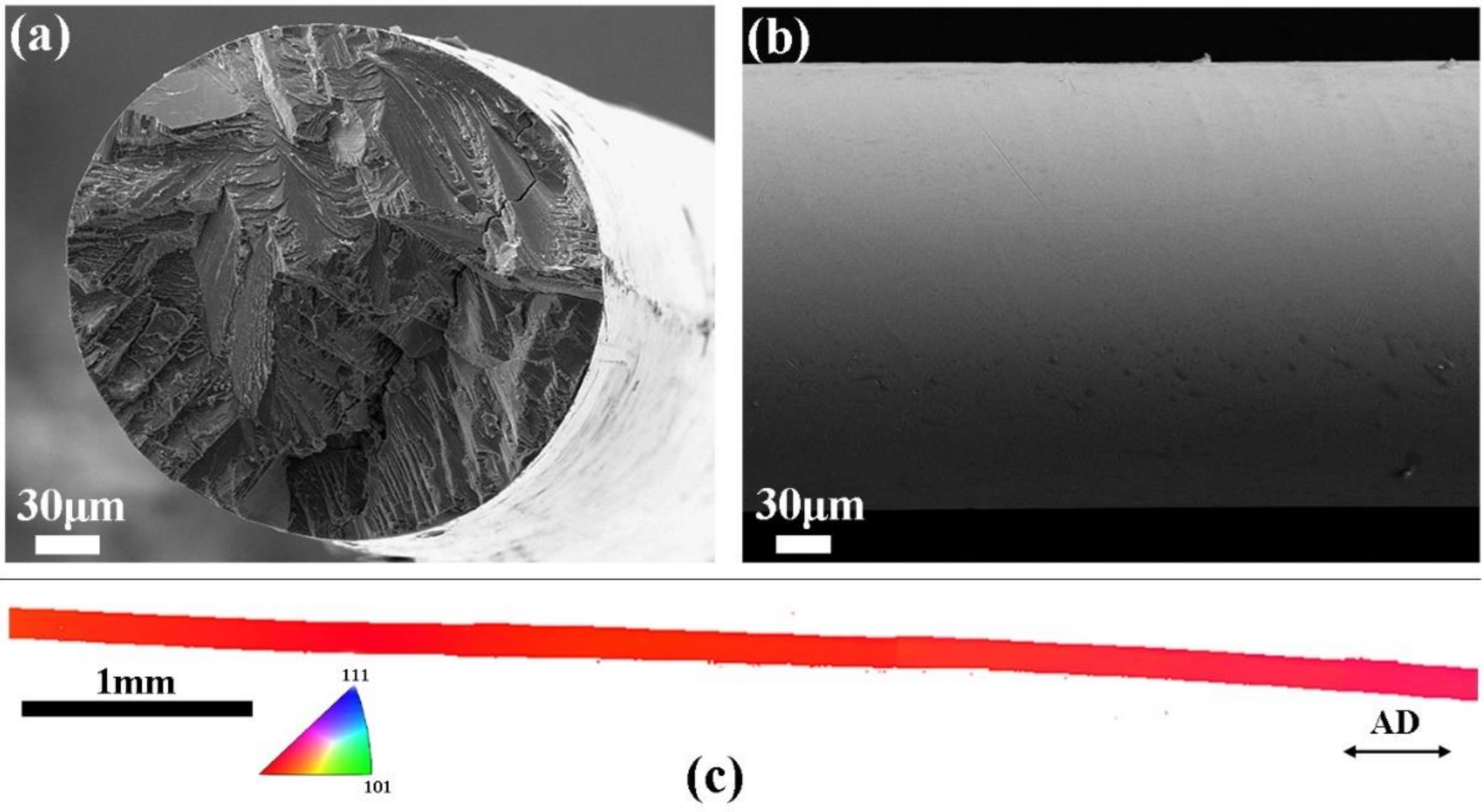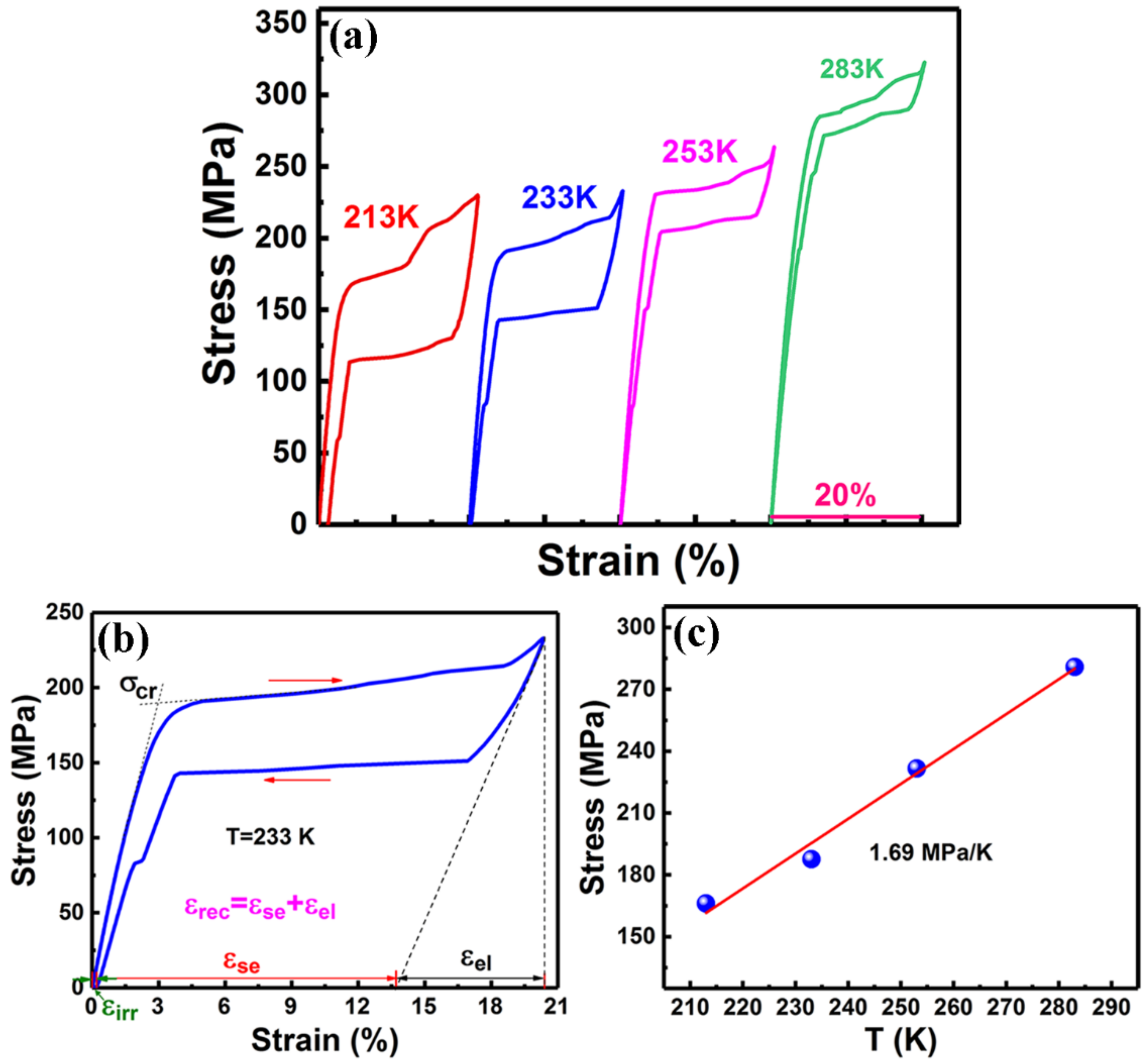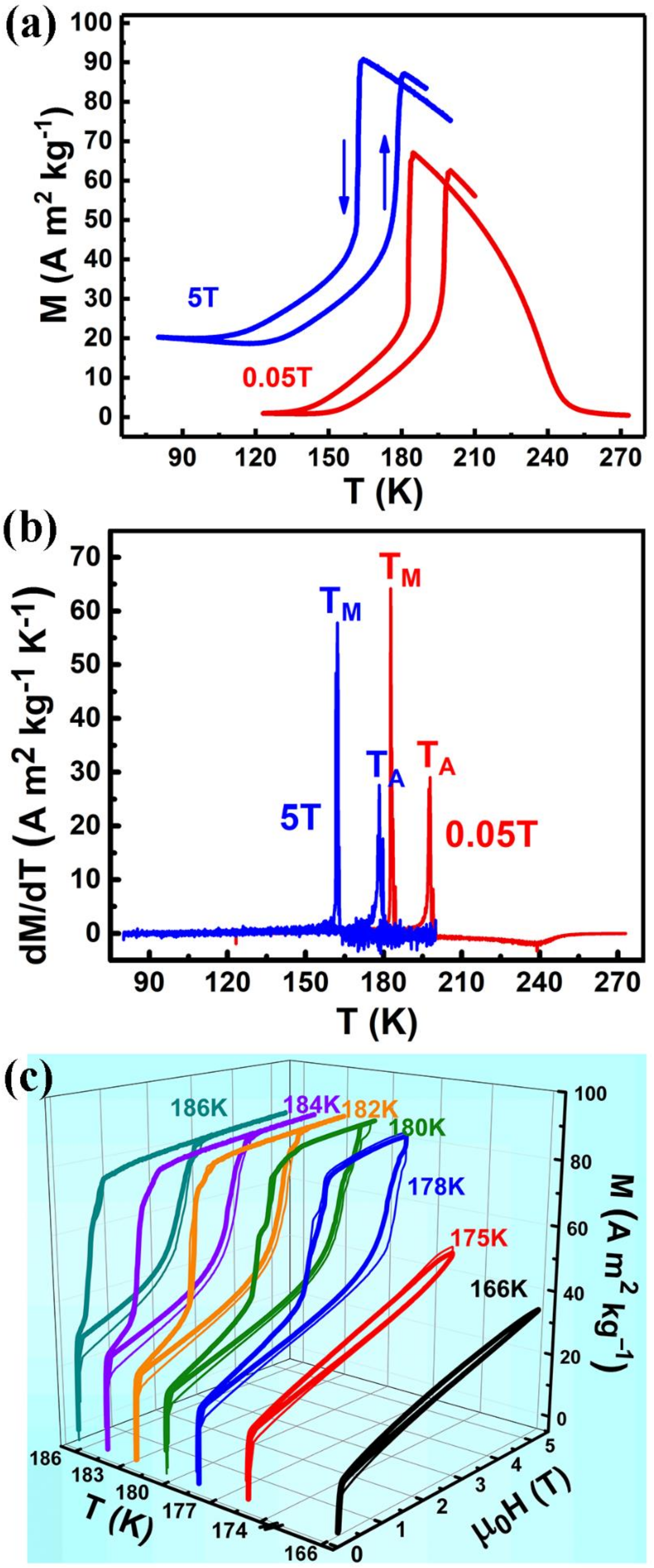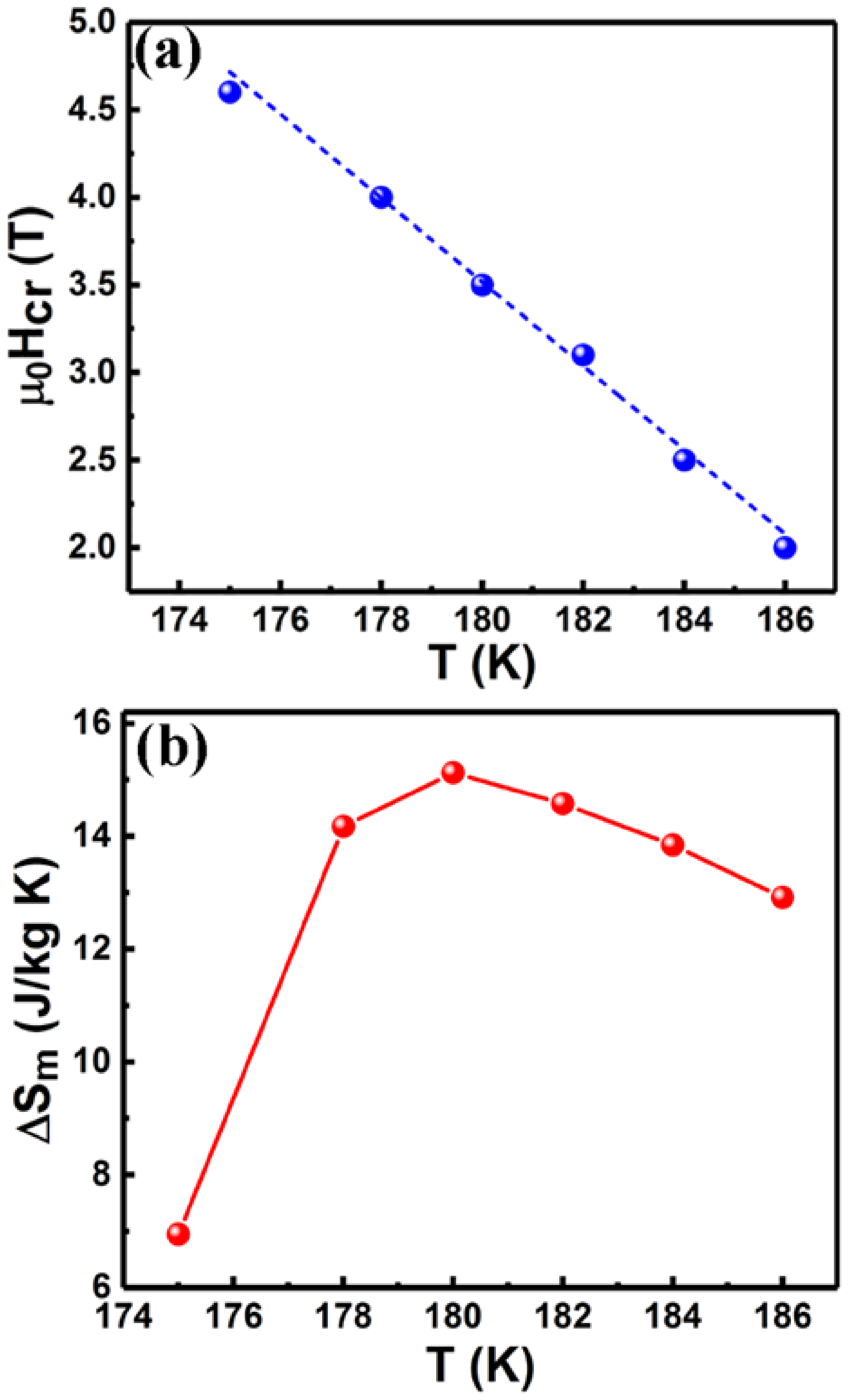External-Field-Induced Phase Transformation and Associated Properties in a Ni50Mn34Fe3In13 Metamagnetic Shape Memory Wire
Abstract
:1. Introduction
2. Materials and Methods
3. Results
3.1. Microstructure and Crystal Structure
3.2. Stress-Induced Phase Transformation and Superelasticity
3.3. Magnetic-Field-Induced Phase Transformation and Magnetocaloric Effect
4. Discussion
5. Conclusions
Author Contributions
Funding
Data Availability Statement
Conflicts of Interest
References
- Otsuka, K.; Wayman, C.M. Shape Memory Materials; Cambridge University Press: Cambridge, UK, 1998. [Google Scholar]
- Jani, J.M.; Leary, M.; Subic, A.; Gibson, M.A. A review of shape memory alloy research, applications and opportunities. Mater. Des. 2014, 56, 1078–1113. [Google Scholar] [CrossRef]
- Sun, L.; Huang, W.M.; Ding, Z.; Zhao, Y.; Wang, C.C.; Purnawali, H.; Tang, C. Stimulus-responsive shape memory materials: A review. Mater. Des. 2012, 33, 577–640. [Google Scholar] [CrossRef]
- Manjaiah, M.; Narendranath, S.; Basavarajappa, S. Review on non-conventional machining of shape memory alloys. Trans. Nonferrous Met. Soc. China 2014, 24, 12–21. [Google Scholar] [CrossRef]
- Wu, M.H.; Schetky, L. Industrial Applications for Shape Memory Alloys. In Proceedings of the International Conference on Shape Memory and Superelastic Technologies, Pacific Grove, CA, USA, 30 April–4 May 2000; pp. 171–182. [Google Scholar]
- Stoeckel, D. Shape memory actuators for automotive applications. Mater. Des. 1990, 11, 302–307. [Google Scholar] [CrossRef]
- Velmurugan, C.; Senthilkumar, V.; Dinesh, S.; Arulkirubakaran, D. Review on phase transformation behavior of NiTi shape memory alloys. Mater. Today Proc. 2018, 5, 14597–14606. [Google Scholar] [CrossRef]
- Choudhary, N.; Kaur, D. Shape memory alloy thin films and heterostructures for MEMS applications: A review. Sens. Actuators A 2016, 242, 162–181. [Google Scholar] [CrossRef]
- Petrini, L.; Migliavacca, F. Biomedical applications of shape memory alloys. J. Met. 2011, 2011, 501483. [Google Scholar] [CrossRef]
- Krenke, T.; Duman, E.; Acet, M.; Wassermann, E.F.; Moya, X.; Mañosa, L.; Planes, A.; Suard, E.; Ouladdiaf, B. Magnetic superelasticity and inverse magnetocaloric effect in Ni-Mn-In. Phys. Rev. B 2007, 75, 104414. [Google Scholar] [CrossRef] [Green Version]
- Mañosa, L.; Moya, X.; Planes, A.; Aksoy, S.; Acet, M.; Wassermann, E.; Krenke, T. Magnetostrain in Multifunctional Ni-Mn Based Magnetic Shape Memory Alloys. Mater. Sci. Forum 2008, 583, 111–117. [Google Scholar] [CrossRef]
- Kainuma, R.; Imano, Y.; Ito, W.; Sutou, Y.; Morito, H.; Okamoto, S.; Kitakami, O.; Oikawa, K.; Fujita, A.; Kanomata, T.; et al. Magnetic-field-induced shape recovery by reverse phase transformation. Nature 2006, 439, 957–960. [Google Scholar] [CrossRef]
- Pathak, A.K.; Dubenko, I.; Pueblo, C.; Stadler, S.; Ali, N. Magnetoresistance and magnetocaloric effect at a structural phase transition from a paramagnetic martensitic state to a paramagnetic austenitic state in Ni50Mn36.5In13.5 Heusler alloys. Appl. Phys. Lett. 2010, 96, 172503. [Google Scholar] [CrossRef] [Green Version]
- Huang, L.; Cong, D.Y.; Ma, L.; Nie, Z.H.; Wang, Z.L.; Suo, H.L.; Ren, Y.; Wang, Y.D. Large reversible magnetocaloric effect in a Ni-Co-Mn-In magnetic shape memory alloy. Appl. Phys. Lett. 2016, 108, 032405. [Google Scholar] [CrossRef]
- Liu, J.; Woodcock, T.G.; Scheerbaum, N.; Gutfleisch, O. Influence of annealing on magnetic field-induced structural transformation and magnetocaloric effect in Ni-Mn-In-Co ribbons. Acta Mater. 2009, 57, 4911–4920. [Google Scholar] [CrossRef]
- Liu, J.; Gottschall, T.; Skokov, K.P.; Moore, J.D.; Gutfleisch, O. Giant magnetocaloric effect driven by structural transitions. Nat. Mater. 2012, 11, 620–626. [Google Scholar] [CrossRef]
- Ueland, S.M.; Chen, Y.; Schuh, C.A. Oligocrystalline Shape Memory Alloys. Adv. Funct. Mater. 2012, 22, 2094–2099. [Google Scholar] [CrossRef]
- Dunand, D.C.; Müllner, P. Size effects on magnetic actuation in Ni-Mn-Ga shape-memory alloys. Adv. Mater. 2011, 23, 216–232. [Google Scholar] [CrossRef]
- Juan, J.S.; Nó, M.L.; Schuh, C.A. Superelasticity and Shape Memory in Micro- and Nanometer-scale Pillars. Adv. Mater. 2008, 20, 272–278. [Google Scholar] [CrossRef]
- Chiriac, H.; Óvári, T.A. Amorphous glass-covered magnetic wires: Preparation, properties, applications. Prog. Mater. Sci. 1996, 40, 333–407. [Google Scholar] [CrossRef]
- Vázquez, M.; Chiriac, H.; Zhukov, A.; Panina, L.; Uchiyama, T. On the state-of-the-art in magnetic microwires and expected trends for scientific and technological studies. Phys. Status Solidi A 2011, 208, 493–501. [Google Scholar] [CrossRef]
- Qian, M.F.; Zhang, X.X.; Witherspoon, C.; Sun, J.F.; Müllner, P. Superelasticity and shape memory effects in polycrystalline Ni-Mn-Ga microwires. J. Alloys Compd. 2013, 577, S296–S299. [Google Scholar] [CrossRef]
- Chen, Z.; Cong, D.; Sun, X.; Zhang, Y.; Yan, H.; Li, S.; Li, R.; Nie, Z.; Ren, Y.; Wang, Y. Magnetic field-induced magnetostructural transition and huge tensile superelasticity in an oligocrystalline Ni–Cu–Co–Mn–In microwire. IUCrJ 2019, 6, 843–853. [Google Scholar] [CrossRef] [Green Version]
- Li, F.Q.; Qu, Y.H.; Yan, H.L.; Chen, Z.; Cong, D.Y.; Sun, X.M.; Li, S.H.; Wang, Y.D. Giant tensile superelasticity originating from two-step phase transformation in a Ni-Mn-Sn-Fe magnetic microwire. Appl. Phys. Lett. 2018, 113, 112402. [Google Scholar] [CrossRef]
- Kraus, W.; Nolze, G. POWDER CELL–a program for the representation and manipulation of crystal structures and calculation of the resulting X-ray powder patterns. J. Appl. Crystallogr. 1996, 29, 301–303. [Google Scholar] [CrossRef]
- Song, Y.T.; Chen, X.; Dabade, V.; Shield, T.W.; James, R.D. Enhanced reversibility and unusual microstructure of a phase-transforming material. Nature 2013, 502, 85–88. [Google Scholar] [CrossRef]
- Hane, K.F.; Shield, T.W. Microstructure in the cubic to monoclinic transition in titanium-nickel shape memory alloys. Acta Mater. 1999, 47, 2603–2617. [Google Scholar] [CrossRef]
- Liang, X.; Xiao, F.; Jin, M.; Jin, X.; Fukuda, T.; Kakeshita, T. Elastocaloric effect induced by the rubber-like behavior of nanocrystalline wires of a Ti-50.8Ni (at.%) alloy. Scr. Mater. 2017, 134, 42–46. [Google Scholar] [CrossRef]
- Ma, J.; Karaman, I.; Noebe, R.D. High temperature shape memory alloys. Int. Mater. Rev. 2011, 55, 257–315. [Google Scholar] [CrossRef]
- Kustov, S.; Corró, M.L.; Pons, J.; Cesari, E. Entropy change and effect of magnetic field on martensitic transformation in a metamagnetic Ni-Co-Mn-In shape memory alloy. Appl. Phys. Lett. 2009, 94, 191901. [Google Scholar] [CrossRef] [Green Version]
- Cong, D.Y.; Roth, S.; Schultz, L. Magnetic properties and structural transformations in Ni-Co-Mn-Sn multifunctional alloys. Acta Mater. 2012, 60, 5335–5351. [Google Scholar] [CrossRef]
- Qu, Y.H.; Cong, D.Y.; Chen, Z.; Gui, W.Y.; Sun, X.M.; Li, S.H.; Ma, L.; Wang, Y.D. Large and reversible inverse magnetocaloric effect in Ni48.1Co2.9Mn35.0In14.0 metamagnetic shape memory microwire. Appl. Phys. Lett. 2017, 111, 192412. [Google Scholar] [CrossRef]
- Liu, G.J.; Sun, J.R.; Shen, J.; Gao, B.; Zhang, H.W.; Hu, F.X.; Shen, B.G. Determination of the entropy changes in the compounds with a first-order magnetic transition. Appl. Phys. Lett. 2007, 90, 032507. [Google Scholar] [CrossRef]
- Balli, M.; Fruchart, D.; Gignoux, D.; Zach, R. The “colossal” magnetocaloric effect in Mn1-xFexAs: What are we really measuring? Appl. Phys. Lett. 2009, 95, 072509. [Google Scholar] [CrossRef]
- Qu, Y.H.; Cong, D.Y.; Sun, X.M.; Nie, Z.H.; Gui, W.Y.; Li, R.G.; Ren, Y.; Wang, Y.D. Giant and reversible room-temperature magnetocaloric effect in Ti-doped Ni-Co-Mn-Sn magnetic shape memory alloys. Acta Mater. 2017, 134, 236–248. [Google Scholar] [CrossRef]
- Szymczak, R.; Nedelko, N.; Lewińska, S.; Zubov, E.; Sivachenko, A.; Gribanov, I.; Radelytskyi, I.; Dyakonov, K.; Ślawska-Waniewska, A.; Valkov, V.; et al. Comparison of magnetocaloric properties of the Mn2-xFexP0.5As0.5 (x = 1.0 and 0.7) compounds. Solid. State Sci. 2014, 36, 29–34. [Google Scholar] [CrossRef]
- Karaca, H.E.; Karaman, I.; Basaran, B.; Ren, Y.; Chumlyakov, Y.I.; Maier, H.J. Magnetic Field-Induced Phase Transformation in NiMnCoIn Magnetic Shape-Memory Alloys-A New Actuation Mechanism with Large Work Output. Adv. Funct. Mater. 2009, 19, 983–998. [Google Scholar] [CrossRef]
- Turabi, A.S.; Karaca, H.E.; Tobe, H.; Basaran, B.; Aydogdu, Y.; Chumlyakov, Y.I. Shape memory effect and superelasticity of NiMnCoIn metamagnetic shape memory alloys under high magnetic field. Scr. Mater. 2016, 111, 110–113. [Google Scholar] [CrossRef]
- Ausanio, G.; Hison, C.; Iannotti, V.; Luponio, C.; Lanotte, L. Elastomagnetic effect in novel elastic magnets. J. Magn. Magn. Mater. 2004, 272–276, 2069–2071. [Google Scholar] [CrossRef]
- Lanotte, L.; Ausanio, G.; Iannotti, V.; Pepe, G.; Carotenuto, G.; Netti, P.; Nicolais, L. Magnetic and magnetoelastic effects in a composite material of Ni microparticles in a silicone matrix. Phys. Rev. B 2001, 63, 811–820. [Google Scholar] [CrossRef]
- Tanaka, Y.; Himuro, Y.; Kainuma, R.; Sutou, Y.; Omori, T.; Ishida, K. Ferrous Polycrystalline Shape-Memory Alloy Showing Huge Superelasticity. Science 2010, 327, 1488–1490. [Google Scholar] [CrossRef]






Publisher’s Note: MDPI stays neutral with regard to jurisdictional claims in published maps and institutional affiliations. |
© 2021 by the authors. Licensee MDPI, Basel, Switzerland. This article is an open access article distributed under the terms and conditions of the Creative Commons Attribution (CC BY) license (http://creativecommons.org/licenses/by/4.0/).
Share and Cite
Chen, Z.; Cong, D.; Li, S.; Zhang, Y.; Li, S.; Cao, Y.; Li, S.; Song, C.; Ren, Y.; Wang, Y. External-Field-Induced Phase Transformation and Associated Properties in a Ni50Mn34Fe3In13 Metamagnetic Shape Memory Wire. Metals 2021, 11, 309. https://doi.org/10.3390/met11020309
Chen Z, Cong D, Li S, Zhang Y, Li S, Cao Y, Li S, Song C, Ren Y, Wang Y. External-Field-Induced Phase Transformation and Associated Properties in a Ni50Mn34Fe3In13 Metamagnetic Shape Memory Wire. Metals. 2021; 11(2):309. https://doi.org/10.3390/met11020309
Chicago/Turabian StyleChen, Zhen, Daoyong Cong, Shilei Li, Yin Zhang, Shaohui Li, Yuxian Cao, Shengwei Li, Chao Song, Yang Ren, and Yandong Wang. 2021. "External-Field-Induced Phase Transformation and Associated Properties in a Ni50Mn34Fe3In13 Metamagnetic Shape Memory Wire" Metals 11, no. 2: 309. https://doi.org/10.3390/met11020309





